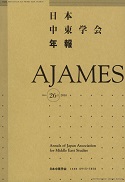Volume 26, Issue 1
Displaying 1-14 of 14 articles from this issue
- |<
- <
- 1
- >
- >|
-
Article type: Article
2010Volume 26Issue 1 Pages 1-40
Published: July 15, 2010
Released on J-STAGE: March 30, 2018
Download PDF (1385K) -
Article type: Article
2010Volume 26Issue 1 Pages 41-74
Published: July 15, 2010
Released on J-STAGE: March 30, 2018
Download PDF (1282K) -
Article type: Article
2010Volume 26Issue 1 Pages 75-97
Published: July 15, 2010
Released on J-STAGE: March 30, 2018
Download PDF (1269K) -
Article type: Article
2010Volume 26Issue 1 Pages 99-135
Published: July 15, 2010
Released on J-STAGE: March 30, 2018
Download PDF (1256K) -
Article type: Special Feature
2010Volume 26Issue 1 Pages 137-150
Published: July 15, 2010
Released on J-STAGE: March 30, 2018
Download PDF (986K) -
Article type: Special Feature
2010Volume 26Issue 1 Pages 151-184
Published: July 15, 2010
Released on J-STAGE: March 30, 2018
Download PDF (1538K) -
Article type: Special Feature
2010Volume 26Issue 1 Pages 185-213
Published: July 15, 2010
Released on J-STAGE: March 30, 2018
Download PDF (1883K) -
Article type: Special Feature
2010Volume 26Issue 1 Pages 215-240
Published: July 15, 2010
Released on J-STAGE: March 30, 2018
Download PDF (3654K) -
Article type: Research Note
2010Volume 26Issue 1 Pages 241-268
Published: July 15, 2010
Released on J-STAGE: March 30, 2018
Download PDF (1469K) -
Article type: Book Review
2010Volume 26Issue 1 Pages 269-272
Published: July 15, 2010
Released on J-STAGE: March 30, 2018
Download PDF (1025K) -
Article type: Book Review
2010Volume 26Issue 1 Pages 273-276
Published: July 15, 2010
Released on J-STAGE: March 30, 2018
Download PDF (916K) -
Article type: Book Review
2010Volume 26Issue 1 Pages 277-280
Published: July 15, 2010
Released on J-STAGE: March 30, 2018
Download PDF (915K) -
Article type: Doctoral Theses in Middle East Studies
2010Volume 26Issue 1 Pages 281-286
Published: July 15, 2010
Released on J-STAGE: March 30, 2018
Download PDF (880K) -
Article type: Doctoral Theses in Middle East Studies
2010Volume 26Issue 1 Pages 287-291
Published: July 15, 2010
Released on J-STAGE: March 30, 2018
Download PDF (794K)
- |<
- <
- 1
- >
- >|
